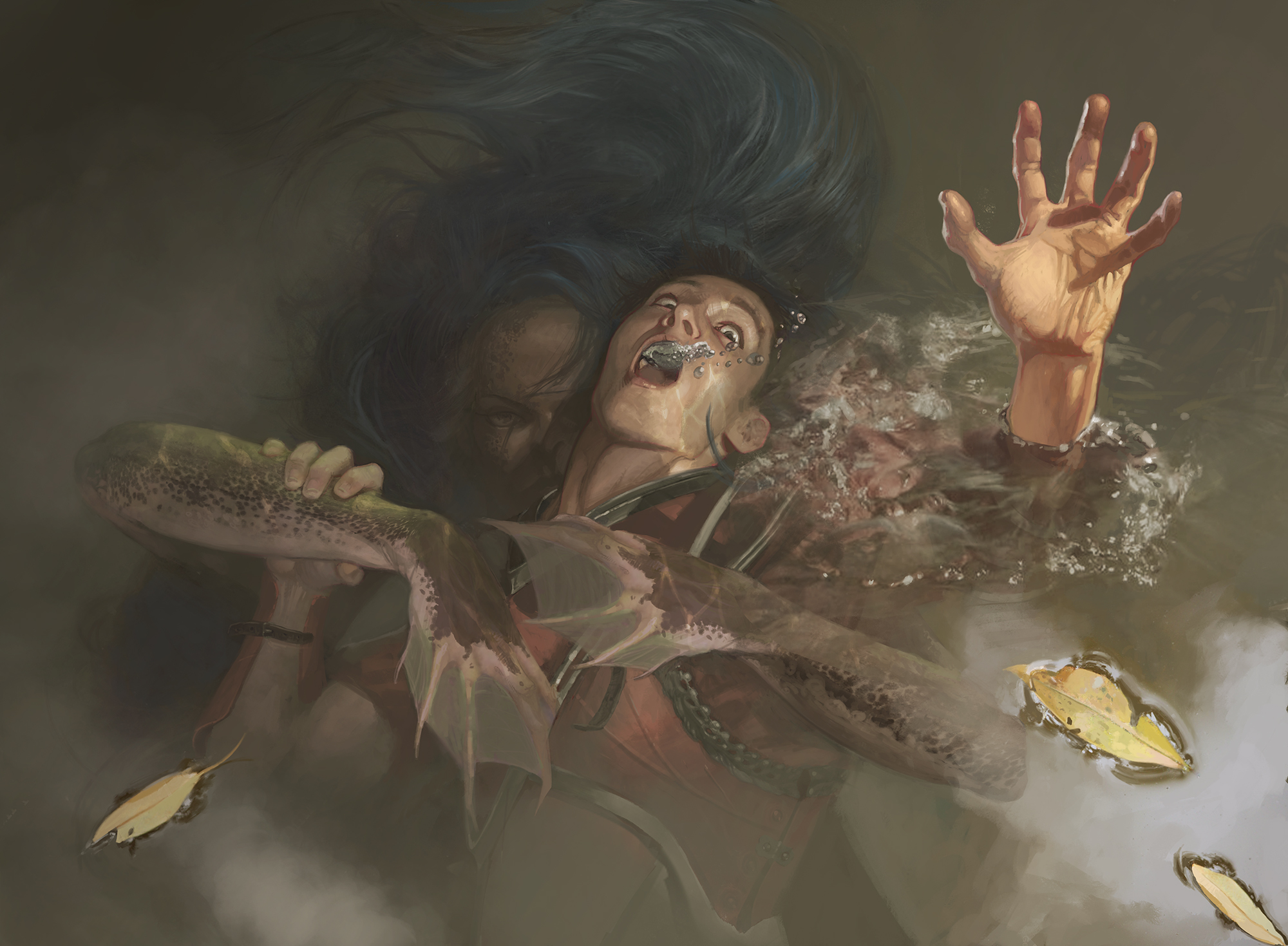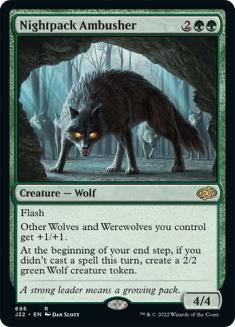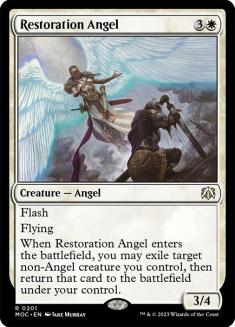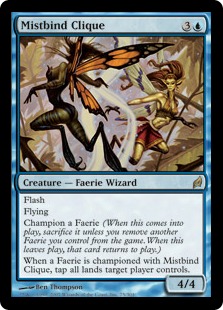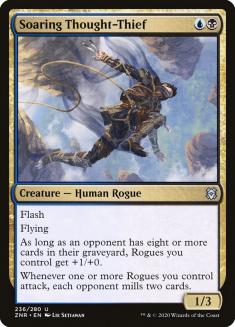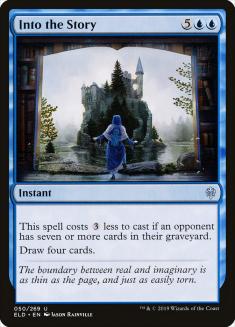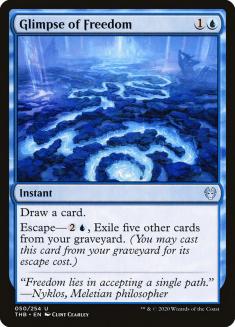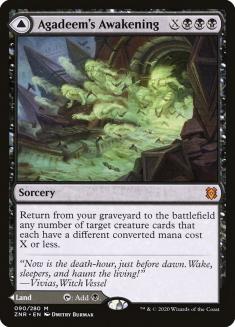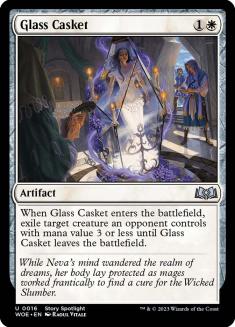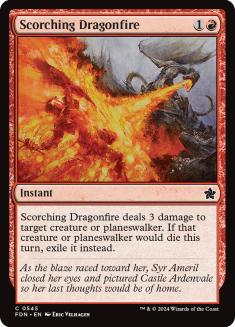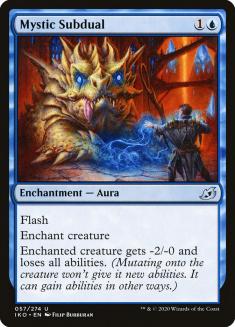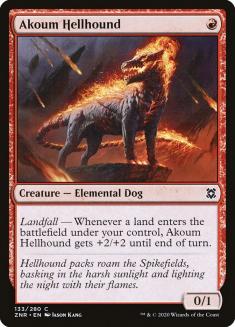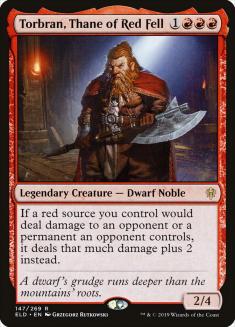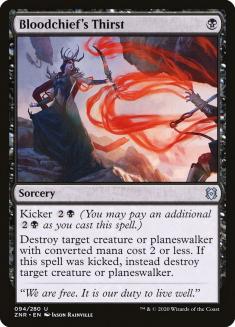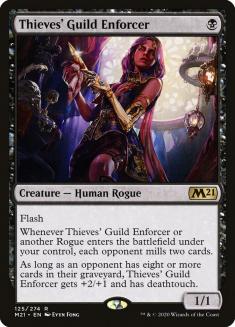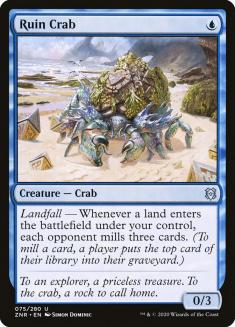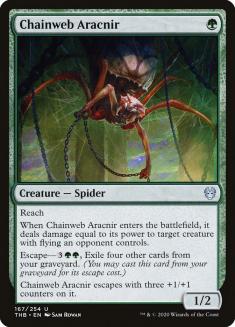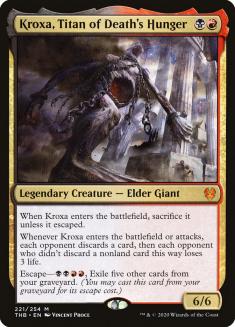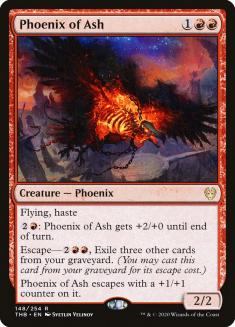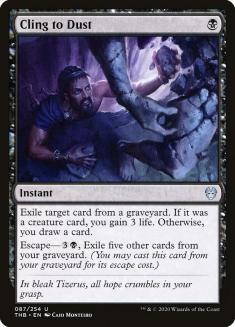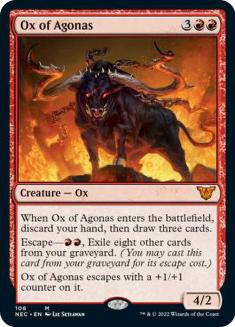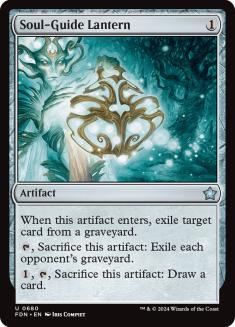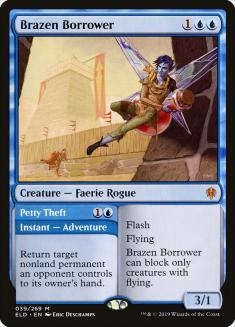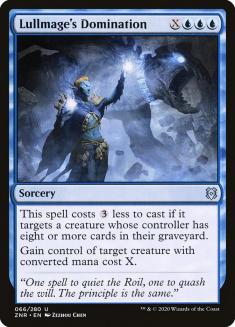While Selesnya Blink was the talk of the town coming out of last weekend, Dimir Rogues was the deck to beat by Friday. While I dismissed Rogues a couple of weeks ago, that was back when the deck had a full curve and clunky sorcery-speed threats like Nighthawk Scavenger. The lists with Lurrus of the Dream-Den or those sacrificing that option for Shark Typhoon are playing a different game of instant-speed interaction and threats, powerful tempo and card advantage options, and spells optimized for cost and efficiency.
Creatures (8)
Lands (24)
Spells (28)

Creatures (15)
Lands (21)
Spells (24)

That’s a fundamentally good deck.
This kind of Flash archetype has been good many times before, and every single time it has been good, it has been uniquely difficult to play against. Your Rogues opponent has the benefit of making their play decisions after you commit to your play every time, so they know the right time to spend mana on removal or when they have the chance to progress their gameplan.
But there has always been the chance to make up the difference there. By knowing how to play around what Dimir Rogues has to offer, you can negate a lot of the edge they get from their instant positioning.
Focus On Their End-Game
One noticeable difference between Dimir Rogues and prior flash-speed Standard menaces is their interactive spells and threats aren’t really how they pull ahead. Their best removal is one-for-one. Their threats aren’t Nightpack Ambushers or Mistbind Cliques that create game-swinging turns.
That flips how you want to think about the matchup a bit. Often your plan against these kind of decks focuses on mitigating their plays that can blow you out horribly. Since Rogues doesn’t have many of those, you can think more about the game ending when they get to execute one of a few specific lines of play. It helps that all of their routes to victory have very specific things gating them, so you can narrow down the relevant axis of the game fairly well.
The main reason you need to think about their interaction is tempo, but you can solve most of that in deckbuilding. If your Dimir Rogues opponent gets to reliably trade a two-cost spell for a four- or five-cost threat, they will have the rest of their mana to take actions that end up killing you. If you take a look at something like Gruul Adventures that had a great weekend in League play, it is overloaded on must-answer two-cost and three-cost spells. In those critical turns where Rogues is looking to answer a play and make progress, it often gets stuck having to fire off multiple answers to stay afloat.
The simplest way Dimir Rogues wins the game is resolving Into the Story. It’s been a while since resolving a card draw spell was sufficient to dominate a game of Standard, but we are finally back to a format that is approximately normal Magic.
Four is a lot of cards. Four mana for four cards is not a lot of mana, and a full-power Into the Story is about as dominating as Fact or Fiction. What the Rogues deck does after drawing that many cards doesn’t matter much; you will likely lose if you give them the chance to cast spells after that point.
The gate here is almost always the “seven cards in graveyard” clause on Into the Story. Paying seven mana for that effect is still a big deal, but spending seven cards on seven lands before casting Into the Story often leaves the Rogues deck light on cards to spend on interaction to make the game close enough to deploy the new cards. Some of this points towards the escape mechanic, which I’ll cover later, but once you start getting to five or six cards in graveyard you take a second to think about giving your opponent a trade that puts you up to that seventh card and leaves them with four mana to immediately Into the Story.
Creatures (25)
- 3 Scavenging Ooze
- 4 Lovestruck Beast
- 2 Questing Beast
- 4 Edgewall Innkeeper
- 4 Bonecrusher Giant
- 4 Brushfire Elemental
- 4 Kazandu Mammoth
Lands (22)
Spells (13)

The other potential gate is the four mana required to cast Into the Story. Think about this in terms of playing Gruul Adventures against Rogues. If you have a big play with immediate impact, like Embercleave or Questing Beast, but are afraid of a Heartless Act from your opponent managing it and letting them double-spell, you’re often looking to line that up so it handles their mana on a turn they would prefer to use it to cast Into the Story. Compare that to casting Lovestruck Beast, which gives them room to cast Into the Story before untapping and handling it.
Along the same “buried in card advantage” lines, Dimir Rogues can use an unopposed Lurrus or an Agadeem’s Awakening recurring Lurrus for a similar result as Into the Story. If you’re trading off for your Rogues opponent’s creatures, and you probably will be, you have a few options to avoid losing to these cards.
The easy-mode option is exiling your opponents’ creatures with removal. I would love to play Fire Prophecy in this format, but Scorching Dragonfire’s exile clause is just too relevant and only gets more relevant if you’re scared of sideboarded Skyclave Shades. In addition to the obvious Glass Casket out of Yorion, Sky Nomad decks, I’ve also found Mystic Subdual to be extremely effective. It’s not an exile, but it completely handles all of the Rogues threats without placing them in a graveyard.
The next-easiest option is exploiting the cost of both of these cards. If you kill your opponent’s creatures but don’t give them a window to spend three mana on the Lurrus companion ability, three mana to cast Lurrus, or sometimes even another six mana to Agadeem’s Awakening it, everything is fine. This is the angle that Mono-Red Aggro takes in most games. It has to kill a Soaring Thought-Thief as just a 1/3 blocker, but if your Rogues opponent spends three mana to do nothing but put Lurrus into their hand, you’re going to win that game.
The last option? Be ready to kill everything and then some. If you can kill their creature, kill their Lurrus after they cast it, and also kill the creature they returned with Lurrus, everything ends up fine. Decks that get in trouble with the first Lurrus cast often try to have one or two removal spells a game, kill a Soaring Thought-Thief, durdle a bit, and then just end up facing down the same Thought-Thief and a Lurrus, unable to really reverse that advantage.
Creatures (4)
Planeswalkers (1)
Lands (25)
Spells (30)

If you do go down that kill-everything route, that’s when Agadeem’s Awakening tends to come into play. Rogues mirrors are often decided by the card, as are games from something like Shota Yasooka’s Dimir Control deck. As games round out into later turns, you should really be allocating a counterspell to a potential Agadeem’s Awakening especially if your opponent has been sitting with an uncast card in hand for a while. Drown in the Loch is a crucial resource in these matchups, and unless you’re forced to use it, you should save it for one of the high-cost card advantage spells.
This is also the point where you can start seeing attacking your Rogues opponent’s graveyard as a good option. If you’re a faster deck I wouldn’t worry about Soul-Guide Lantern or something similar, but Cling to Dust is crucial for multiple reasons in the Rogues mirror.
Now we can start talking about things that are winning the game in the normal rules-book sense of the term. Rogues actually ends games via damage most of the time, but they don’t have a lot of ways to convert smaller chips of damage into a fast clock. If your opponent sticks multiple Soaring Thought-Thieves you die pretty quickly, but outside of that scenario they almost always have to connect with a boosted Thieves’ Guild Enforcer for a fast kill.
Creatures (9)
Lands (31)
Spells (40)

This is a common way for Yorion decks to lose this matchup. In a statement that runs a bit counter to the previous discussion about trading off for single things being a losing proposition, Yorion decks should really be trying to stymie Enforcer beats with Omen of the Sun or Shark Typhoon tokens early. If your early plays don’t actually stop your opponent’s initial pressure it is too easy for Rogues to counter a Yorion, eat a turn of tempo, and close out from there.
Finally, Rogues can win via mill. This is largely irrelevant until the point it isn’t. I don’t usually get worried about losing to decking until I get to about twenty cards left, maybe a bit higher if I’m playing Yorion and many of my good plays involve drawing cards. If your opponent appears to be on the no-Ruin Crab list, you can care even less about this plan since the only mill end-games that don’t just result in lethal damage involve stacks of unanswered Thieves’ Guild Enforcers.
Even if everything lines up for mill to matter, all it means is you have to kill your opponent instead of doing literally nothing. Again, this is an issue you can solve in deckbuilding. Don’t build a slow deck that doesn’t clock your opponent. Play Dream Trawler or something.
The Obvious Escape
Since so many cards in Dimir Rogues are forced mills and rely on opponent’s graveyard size, cards with escape like Chainweb Aracnir have become the default anti-Rogues cards. But not all of these cards are equal in the fight.
The absolute best escape cards against Rogues are the creatures. If you escape a noncreature like Cling to Dust you get some small advantage, but if you escape a Phoenix of Ash your Rogues opponent has to spend mana to answer it or they die. And then it happens again, and again, and again.
That isn’t to say noncreature escape spells are unwelcome, but they are more tactical ways to attack your opponent than ways to brute-force to a win. If you’re playing an Azorius or Dimir deck where you’re likely to lean on Cling to Dust or Glimpse of Freedom, you should be escaping these cards to keep your opponent off their cards-in-graveyard counts. If your opponent has already filled your graveyard past the point that is a reasonable goal, which is usually in ten-to-thirteen card range, you’re better off pressuring them and choking them on time to find and utilize all those reverse threshold payoffs. This also applies if they have an unanswered Soaring Thought-Thief or Ruin Crab, since the trade of them filling your graveyard for free and you spending mana to clear it won’t end well.
High escape numbers are a mixed bag. They regress the Rogues cards the furthest, but your opponent can often set up a short window to fire off Into the Story before you escape Ox of Agonas, which might just be the game. The higher escape numbers also give your opponent more chances to Cling to Dust or Soul-Guide Lantern away your escape creature if it gets milled early, or sometimes give them another window if they can just kill it once and leave you stalled on graveyard content for another recast. This is even more true if the cost to escape the card is high, and adding this together, you can see why Chainweb Aracnir is actually less scary for Dimir Rogues than the Rakdos color escape options.
Avoiding the Blowouts
Even if Rogues is light on cards like Spellstutter Sprite or Nightpack Ambusher that horribly punish slight sequencing missteps, there are a couple of ways things can fall apart when playing against the deck you need to look out for.
My latest weapon of choice in Zendikar Rising Standard has been Mono-Red Aggro, and there’s a really common issue when Soaring Thought-Thief can line up with Fervent Champion. If you can avoid casting 1/1 or 2/1 creatures, do that, and if you can’t, you really need ways to make that combat interaction not a disaster. With Fervent Champion, a Stomp or Boulder Rush cleanly takes care of that, but I often find myself not attacking with a Fervent Champion on Turn 3 because I would rather efficiently tap out for an Anax, Hardened in the Forge.
If your opponent doesn’t reveal Lurrus of the Dream-Den but isn’t playing the clunkier Rogues, they almost certainly have Shark Typhoon and might have Brazen Borrower. Neither card is especially hard to play around, yet they are easy to forget about and lose to.
When playing a Yorion deck, Mystical Dispute is one of the cards that impacts your deck a little harder than usual. There’s often a point where you have to decide whether to wait and play around leaving up the mana or just run right into your opponent’s counterspell, especially when casting an expensive blue spell. I tend to just run my cards out there and hope it works out, but there are scenarios where you’re high on assorted low-impact resources and light on finishing plays like Yorion where it’s worth a second to consider whether you can wait the extra three turns.
Dimir Rogues also isn’t a deck with an unlimited supply of counterspells. Most lists have four Drown in the Loch, then a mix of small numbers of Essence Scatter, Didn’t Say Please, Mystical Dispute, and Negate to back that up. If you have two or three things to cast that they have to spend a counterspell on, you can often just jam through. Maybe if you’re expecting them to sideboard up to ten or more counterspells with extra Mystical Disputes you should adjust, but Game 1 just fire away.
The last big blowout centers largely around the other companion people still play: Lurrus of the Dream-Den. Lullmage’s Domination is a fine card against large green creatures, but where it really shines is Rogues mirrors. The number of Dominations your opponent has is likely low, the cost fairly extreme, and the upside of an unanswered Lurrus fairly high, but similar to the Agadeem’s Awakening situation you should consider a card stuck in your opponent’s hand might be a Lullmage’s Domination and not just lose the game when they gain control of your Lurrus.
Execute Your Gameplan
The Rogues matchup can seem like a lot. You need to track both graveyards, both life totals, and both library counts, all while playing around the constant unknown of instant-speed plays. But if you really look at the deck, you can cut a lot of that away and focus only on the few things that matter.
My last bit of advice? When you aren’t quite sure what to do, try to be proactive. Like I said, the matchup is less scary than it feels at first.

